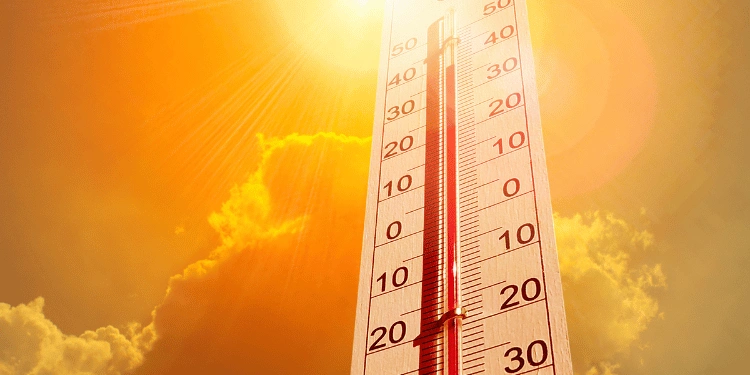Marathon Weather Warning: What Runners Need to Know About UK’s Rising Temperatures
The UK’s Mini Heatwave: What to Expect
As the UK braces for a particularly warm spell, temperatures are set to soar up to 24C in some regions next week.
This dramatic rise comes at a time when the seasonal average typically hovers around 13-14C.
Understandably, such a shift will have many in large portions of England experiencing unusually warm conditions.
Meteorologists suggest that this striking temperature increase, though significant, does not classify as an official heatwave but rather a ‘very warm spell’.
The South East is likely to see the highest temperatures, with forecasts indicating that Monday and Tuesday could reach the peak of this mini-heatwave.
In fact, areas in central and south-eastern England are predicted to experience temperatures some 10C above the seasonal norm.
The increase in warmth can be attributed to a combination of increased sunshine and a shift in wind direction.
This change will mean that while central and southern regions bask in the sun, northern areas will continue to contend with some cloud and scattered showers.
As we move forward, the key takeaway is how this warm weather will affect various aspects of life, particularly for those involved in outdoor activities such as marathons.
The warm conditions are set to pose unique challenges, which will be discussed in detail in the subsequent sections.
London Marathon: Weather Challenges Ahead
With 56,000 participants gearing up for the London Marathon, this year’s event comes with some unexpected weather hurdles.
As temperatures are set to hit between 21C to 22C, runners will face unseasonably warm conditions for the 26.2-mile journey.
Unseasonal Heat
The London Marathon coincides with a developing warm spell, which will see a significant rise in temperatures.
Usually, in late April, London experiences milder weather, but this year is breaking the norm.
With temperatures reaching up to 22°C, marathoners face heightened risks of dehydration and heat exhaustion.

Managing the Heat
Navigating the marathon under these conditions requires careful preparation.
Runners need to adjust their hydration strategies, ensuring they stay adequately hydrated throughout the race.
Pace is another crucial factor; running too fast in such heat can lead to overheating.
Lastly, selecting lightweight, breathable clothing and using sun protection can mitigate the weather’s impact.
This warmer spell is set to challenge both experienced and novice runners, making it essential to adapt accordingly.
Transitioning from the balmy London weather, we now turn our attention to the varied conditions expected in the Manchester Marathon experience further north.
Manchester Marathon: A Different Weather Story
Warmer but Milder Conditions
While the London Marathon will face intense heat, the Manchester Marathon’s weather promises to be more forgiving.
Participants in Manchester can expect peak temperatures of around 17C in the afternoon.
Although warmer than usual for April, it’s significantly cooler than the temperatures anticipated in London.
Cooling Breeze and Sunshine
The day will not be without its challenges, however.
A gentle south-westerly breeze will be present, offering some respite from the heat and helping runners better manage their body temperature.
This light breeze could be a welcome companion for those making their way through the 26.2 mile course.
Preparing for Variability
Spells of sunshine are expected throughout the day, which means runners should still prepare for sun exposure.
It’s crucial to don appropriate clothing and use sun protection to avoid overheating and sunburn.
While Manchester may not experience the same level of intensity as London, proper preparation is essential to ensure a safe and effective run in these warmer-than-average conditions.
As the warmth embraces Manchester, it’s time to shift our focus to understanding the broader regional variations in the UK during this warm spell.
Understanding the Weather Pattern
Warm spell begins Sunday with temperatures rising throughout the weekend
As we approach the weekend, the UK is gearing up for a remarkable warm spell.
Starting on Sunday, temperatures will gradually increase, hitting peaks that are well above the seasonal average.
This surge in warmth is mainly driven by heightened sunshine and a noticeable shift in wind direction.
Increased sunshine and shift in wind direction driving the temperature rise
A lot of central and south-eastern England could see temperatures around the low to mid 20s on Monday and Tuesday, quite potentially reaching up to 24C.
This is notably 10 degrees higher than the usual average for this period, as explained by Met Office meteorologist Simon Partridge.
Not an official heatwave but classified as a ‘very warm spell’
While this weather phenomenon isn’t officially classified as a heatwave, it’s rightfully termed a ‘very warm spell.
‘ Expect sunny days with less cloud cover and more intense sunlight, especially affecting large portions of England.
Despite these warmer conditions not breaking records, they are significantly above what is typical for late April.
These developments set the stage for various outdoor events, particularly marathons, highlighting the importance of understanding and preparing for such unexpected warmth.
Regional Weather Variations
With the mini heatwave coming into effect, the UK will experience notable temperature differences across various regions.
“The South East is expected to experience the highest temperatures, potentially reaching as high as 24°C. This is a significant leap from the usual 14C experienced during this time of year.
Large chunks of England will bask in this unusually warm weather, providing a brief but welcome respite from the cooler temperatures typical of the season.
South East Soars
The South East, including London, will see the highest temperatures, making it one of the warmest areas in the country.
Such warmth is expected to enhance outdoor activities and events, but it also calls for caution due to the increased risk of heat-related health issues.
Northern Regions
Contrastingly, the northern regions will face a different weather scenario.
While they will also enjoy some pockets of sunshine, these areas are expected to experience cloudy conditions and scattered showers.
Temperatures in these regions will not climb as high, potentially staying closer to their seasonal averages.
Significant Temperature Differences
The disparity in weather conditions across the UK is striking.
On one hand, the South East could enjoy sun-drenched days with near-summer temperatures.
On the other, the North will likely contend with a mix of sun, cloud, and occasional rain.
This broad range of conditions highlights the UK’s diverse climate even over short periods, adding to the unpredictability for events planned across various regions.
Understanding these variations can help residents and participants in events like marathons to better prepare for their local weather conditions and plan accordingly.
Marathon Running in Heat: Preparation Tips
Importance of Hydration Strategies
Running a marathon in the UK’s upcoming mini heatwave, where temperatures may hit 24C, requires excellent hydration strategies.
Since conditions will be well above the seasonal average of 13-14C, staying hydrated isn’t just important; it’s crucial.
- ☀️Start Early: Begin hydrating days before the race. Drink water regularly, and consider sports drinks to boost electrolyte levels.
- ☀️During the Race: Stay hydrated by drinking fluids regularly, preferably from water stations along the route. A combination of water and electrolyte drinks helps prevent overheating and mineral depletion.
Adjusting Pace Expectations
High temperatures can significantly impact pace. Maintaining a steady and manageable pace is essential as the warmth adds extra stress on the body.
- ☀️Slow Down: Consider running at a slower pace than usual to better cope with the heat. The aim is to conserve energy and prevent overheating.
- ☀️Listen to Your Body: Pay attention to signs of fatigue or heat exhaustion. If you feel dizzy or overly tired, slow down or take a break until you recover.
Considerations for Appropriate Clothing and Sun Protection
Choosing the right clothing and sun protection can make a big difference when running in such warm conditions.
- ☀️Lightweight and Breathable Fabrics: Wear light, moisture-wicking clothing to keep cool. Avoid heavy fabrics that trap heat.
- ☀️Sun Protection: A hat and sunglasses can protect you from the sun, while applying sunscreen can prevent sunburns. Opt for light-coloured gear to reflect rather than absorb sunlight.
Entering the marathon fully prepared for these higher temperatures will help ensure a safer and more enjoyable running experience.
Looking Beyond the Weekend
Temperature Spike
As we look beyond the weekend, Monday and Tuesday are projected to experience the warmest temperatures of this “very warm spell”.
The South East could see the mercury rising up to 24C, placing the region significantly above the seasonal average of 13-14C.
Other parts of central and south-eastern England could find themselves basking in temperatures in the low to mid 20s. This unexpected warmth means some regions will be as much as 10C hotter than usual for this time of the year.
Weather Changes
However, the weather pattern is expected to become more changeable after these initial warm days.
While Monday and Tuesday promise to remain dry and bright in general, the forecast suggests a shift towards cloudier conditions as the week progresses.
It’s anticipated that the increased sunshine early in the week will give way to periods of cloud cover, offering some respite from the mini heatwave.
Regional Variations
Across the UK, regional variations will continue to be pronounced.
While the southern and eastern parts will enjoy more stable sunny weather, the northern areas might see some cloud and scattered showers even on the sunniest days.
Such discrepancies highlight the importance of regional forecasts for those planning activities and events.
Running through this brief warm spell requires careful preparation, whether you are participating in a marathon, engaging in outdoor activities, or simply going about your daily routine.
Knowing what to expect can help you manage and possibly enjoy the upcoming weather.






